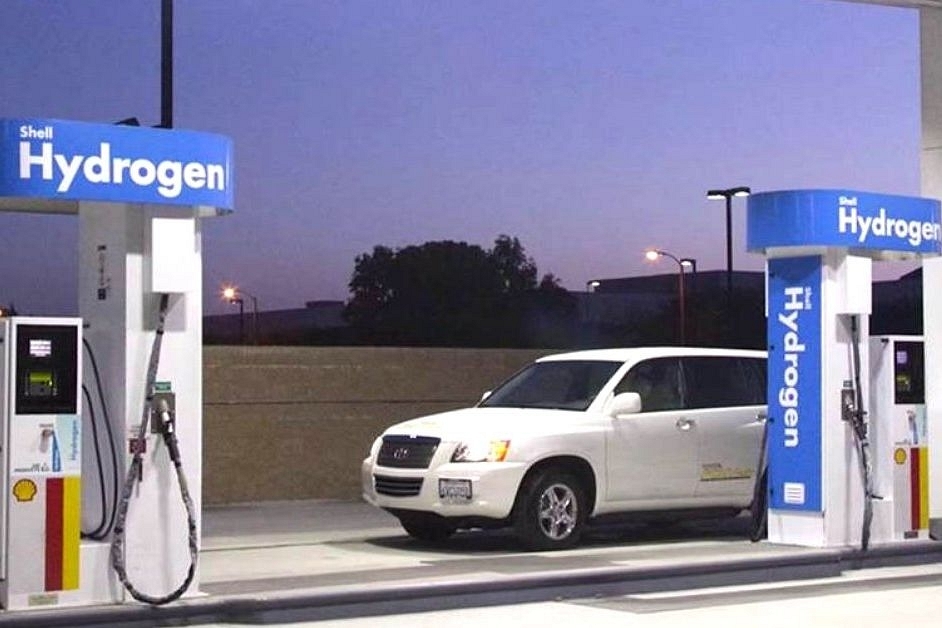Science
Hydrogen Mission In Budget 2021: The Future Here, Now
- Clearly, the Modi government has initiated an ambitious project to bring a futuristic, green, and efficient energy technology into India.
- If played right, this has the potential of making India a global leader and net exporter of green technology.

A hydrogen filling station. (representative image) (via Twitter/@thebetterindia)
One important announcement in this budget presentation is the announcement of the launch of a National Hydrogen Mission in 2021-22 for generating hydrogen from green power sources.
Already, Swarajya has come out with a broad outline of what it means for clean green energy and economics. Here are some more details.
The Modi government has already been doing some serious ground work with respect to this future green energy technology.
In January 2020, speaking at the Renewable Energy Summit of India Energy Forum, the secretary of the Ministry for New and Renewable Energy, Anand Kumar, had stated that the Modi government was working on setting up a hydrogen mission wherein hydrogen, as a clean energy source, would be used to 'decarbonise' industries and aviation.
Since then, various investment proposals and research projects have been getting explored. In February last year, a hydrogen-fuel-cell based bus project was being worked out in the newly formed Union Territory of Leh region.
Then, in April 2020, the National Thermal Power Corporation (NTPC) Ltd, India's largest power producer and a central PSU under the Ministry of Power, has invited Global Expression of Interest (EoI) to provide 10 Hydrogen Fuel Cell (FC) based electric buses and an equal number of Hydrogen Fuel Cell based electric cars in Leh and Delhi.
Then in November 2020, NTPC spoke about the launch of a pilot project on Hydrogen fuel cell-based transportation service to the Hill Council, Leh.
The first-of-its-kind project in India is in line with PM Modi’s efforts to make Ladakh a carbon-neutral region, while making its connectivity with the rest of the nation improve so that there will be development.
The project also comes with a plan for setting up of a Hydrogen plant in Leh, which will also increase the job opportunities in the region.
The same month, Modi told a global investors' meet on Renewable Energy of the plans of launching a National Hydrogen Energy Mission.
This Mission is part of the plan to 'generate business prospects of the order of around Rs 1.5 lakh crore rupees or $20 billion per year'.
Dr. Chaitanya Giri, a space scientist now with Gateway House, a foreign policy think-tank established in 2009, speaking to Swarajya, points out that as early as 2004, Vajpayee's NDA wanted a hydrogen technology route map.
Unfortunately, the post-2004 regime did not do much work in this direction. In a very important thoroughly studied policy paper which he published in 2019, Dr. Giri draws attention to certain emerging trends with respect to hydrogen technology globally.
In this paper, he points out the formation of the Hydrogen Council, a global business alliance of more than 50 large global corporations across various sectors.
Formed during the 2017 World Economic Forum in Davos, this council intends to devise a mutually agreed upon action plan and shape pioneering international policies for the emerging hydrogen economy.
Dr. Giri suggests in the paper that India with its own hydrogen sector should engage with bodies like Hydrogen Council. Actually engaging decidedly and proactively in emerging hydrogen technologies can help India expand its infrastructure building into other developing countries.
Dr. Giri strongly feels that concentrating in a big way in hydrogen technology will help India ‘make strategic overseas investments and export hydrogen fuel generation systems, storage infrastructure, gas-filling stations and hydrogen-powered transport systems, to different regions of the developing world, particularly South-East Asia, Central Asia, Africa and South America.’
Towards this end, he advocates inter-ministry innovative linkage of flagship programmes of the Modi government with the National Hydrogen Mission:
Indian Railways also can tap into this technology which can be a great game changer, according to Dr. Giri.
Clearly, the Modi government has initiated an ambitious project to bring at good speed a futuristic green efficient energy technology into India that can make India a very important global player in future green energy technologies.
If played right, this has the great potential of making India a global leader and net exporter of green technology.
Support Swarajya's 50 Ground Reports Project & Sponsor A Story
Every general election Swarajya does a 50 ground reports project.
Aimed only at serious readers and those who appreciate the nuances of political undercurrents, the project provides a sense of India's electoral landscape. As you know, these reports are produced after considerable investment of travel, time and effort on the ground.
This time too we've kicked off the project in style and have covered over 30 constituencies already. If you're someone who appreciates such work and have enjoyed our coverage please consider sponsoring a ground report for just Rs 2999 to Rs 19,999 - it goes a long way in helping us produce more quality reportage.
You can also back this project by becoming a subscriber for as little as Rs 999 - so do click on this links and choose a plan that suits you and back us.
Click below to contribute.
Latest